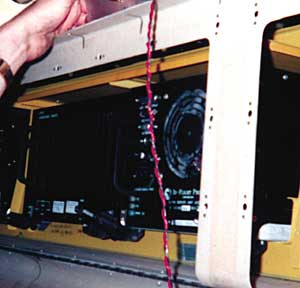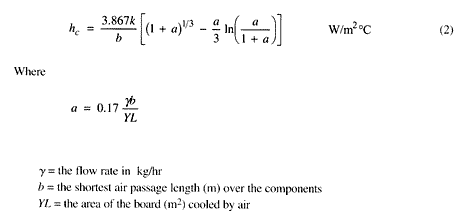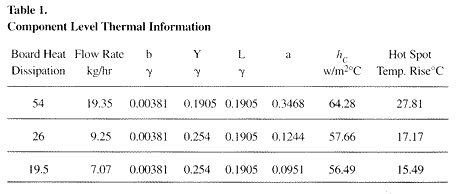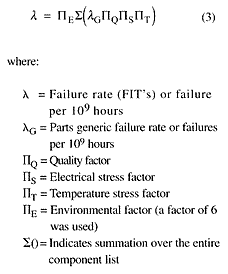In the avionics industry, regulatory agencies and standards organizations, such as Federal Aviation Regulation (FAR) [1], Aeronautical Radio, Inc. (ARINC) [2], and Radio Technical Commission for Aeronautics (RTCA) [3], have developed sets of test procedures that help design engineers test and verify their designs and prevent any safety-threatening failures. Too often, however, thermal, mechanical and reliability evaluations have been left up to these tests as the last items on the design agenda with no analysis taking place. This practice relies heavily on the designer’s previous experience and
This article discusses analysis of a commercial aviation electronic package for which the original design and development cycle did not include mechanical or thermal concerns. The unit discussed here was an integral part of an in-flight telephone and entertainment system: an ARINC 746 [2] Cabin Telecommunication Unit (CTU) depicted in Figure 1.
 |
Figure 1. The CTU configuration.Although, the design criteria for this system were developed according to FAR, ARINC and RTCA regulations and standards, the first series of production units failed within the first ninety days of field operation. The manufacturer attempted to address these failures without using any analytical methods, but was disappointed that units continued to fail. Consequently, a thorough analysis of the systems was conducted, and subsequent design modification were to be based on both analytical results and field observations.
Design Parameters
Based on various regulations and standards, the following set of design parameters was developed.
Operational Characteristics
The CTU is similar to a public branch exchange (PABX) computer. It generates commands for establishing and terminating air/ground, air/SATCOM and seat/seat communications.
Reference Documents
To gain FAA certification and industry acceptance for this device, compliance with ARINC 746, ARINC 600, RCTA/DO-160C, and FAR Part 25 is mandatory.
Mechanical and Thermal Design Specifications
The mechanical design specifications are as follows:
- Unit weight under 9 kg (20 lbs).
- Size limit of 6 MCU per ARINC 600 standards. Measuring 0.1905m W x 0.3241m L x 0.1941m H, the MCU (Modular Concept Unit) is the basic building block module used in commercial aircraft system design.
- Must not create fire or smoke considered hazardous to flight operations. FAA rules prohibit use of any cables jacketed with PVC. All PCB’s must be FR4-G10 or better.
- Must use aluminum sheet metal packaging. The assembly must retain its mass during sudden deceleration – 12 g’s per FAR part 25 and RTCA/DO-160C crash safety regulations.
- Temperature range from -15oC to 55oC and altitude range from zero to 4,572 meters (15,000 ft). No temperature derating is permitted.
- Air weight flow of 220 kg/hr kW at 40oC and 1013.25 mbar per ARINC 600. No exterior side surface may exceed an average of 60oC and no single point on the surface may exceed 65oC at an inlet temperature of 55oC (ground) and an altitude of 4,572 meters (15,000 ft).
Electrical Parameters
The electrical system parameters are as follows:
- 130 Watts of output with a minimum power factor of 0.90 and a minimum efficiency of 80% for the unit’s power supply.
- 115 volts AC nominal input voltage at 1.6 amps, and an input of 184 VA. This gives a system thermal dissipation between 165.6 and 184 Watts.
Analysis
The mechanical analysis focuses on the following areas per ARINC 600 requirements. These are thermal analysis and stress analysis due to the 12 g forces as well as random vibration loads (per RTCA/DO-160C requirements). (Electrical and/or electronic analysis of the CTU is beyond the scope of this article.)
Reliability and Mean-Time-Between-Failures (MTBF) calculations are yet another aspect of analysis, which will be dealt with briefly [4,5]. In this application, Bellcore Standard TR-332, Issue 5 is used to derive a lifetime estimate for the electronics. Other methods may be employed to calculate the mechanical (fatigue) lifetime of the packaging itself.
Thermal Analysis
The CTU has the following components and maximum potential heat dissipation distributions (a total of 184 Watts)
- PCB 1- Microprocessor Board, 26 W
- PCB 2- Memory Board, 26 W
- PCB 3 – Network Board, 19.5 W
- PCB 4 – Network Board, 19.5 W
- PCB 5 – Power Supply, 54 W
- PCB 6 – E1 Network Board (quantity 2), 19.5 W
The following relationship holds [6].
 |
Where Q is the total heat (Watts) and T is the exit to inlet temperature rise (oC). y is the flow rate.Based on this equation, the flow rate is 65.88 kg/hr for a 10oC temperature rise. ARINC 600 regulations require use of 220 kg/hr kW (maximum), leading to a flow rate of 40.48 kg/hr (=220 x 184 /1000), which produces a temperature rise of 16.3oC.
Since there is a discrepancy between the required flow rate and the available flow rate, an innovative solution was sought. The ARINC standard avionics rack system (implemented in the electronics bay of the airplane) provides coolant air to all electronic equipment including the vital systems. However, it is possible to develop a private rack in the cargo bay using the cabin air, which delivers coolant air independent of the standard system, thereby eliminating any regulatory restrictions on the availability of coolant air flow. Figure 2 shows the rack with the CTU in place.
 |
Figure 2. The rack assembly, CTU, and other electronics in the cargo bay.To calculate the component temperatures, one must first calculate the flow rate over each board and then calculate a local heat transfer coefficient (hc) using a semi-empirical formula [6,7].
 |
The hot spot temperature rise may be calculated by adding the maximum inlet to exit temperature rise to the temperature rise calculated using equation (2) and the board area. Table 1 may be constructed based on Equations (1) and (2) and a maximum temperature rise of 10oC and air conductivity of 0.05 W/moC.
 |
To verify these results, one may sum the flow rate over each board, adding up to 65.95 kg/hr which is in close agreement with the value calculated earlier. To provide this flow, a 400 Hz Rotron fan, delivering 16.9 lt/s (36 CFM), will be used; only 15.1 lt/s (32 CFM) is required.
Load Carrying and Vibration Analysis
An FEA static analysis using 4,446 shell elements showed that the system can withstand the required 12g static loading. The Von Mises stresses were significantly below any yield values except at the spot welds where yielding might have occurred. (This box had 5 spot welds along the two sides of the top plate.) Furthermore, a random vibration analysis was performed in three axes per RTCA/DO-160C procedures. The input level was 0.01 g2/Hz for 10 to 2,000 Hz range. The stresses generated by random vibrations may be used to estimate a mechanical lifetime [6] for the PCBs and the box. (Detailed discussion of this approach is beyond the scope of this article.)
Based on the stresses provided by both static loading and random vibrations, each weld carries a maximum load of 1.3789×108 Pa (20,000 psi). These numbers exceed yield stresses of aluminum and indicate plastic flow in the weld. Lifetime calculations produce an estimated 1,071 hours (44 days). Field production units clearly demonstrated failures within ninety (90) days. Simulations were repeated for a hypothetical case where the number of spot welds were increased to eight. This subsequently reduced random stress levels to nearly 8.9628×107 Pa (13,000 psi) and increased the calculated lifetime to nearly nine years.
Reliability and MTBF Calculations
Since this system is defined as telephone equipment rather than avionics, the reliability calculations for this system were based upon Bellcore TR-332 [4], Issue 5, rather than MIL-HDBK-217F [5]. The following equation was used to generate the system failure rate:
 |
First Year Electronic Failures
Based on Equation (3) the failure rate for this system has been calculated as:
(Details of failure rate calculations are beyond the scope of this article.)
The AT&T Reliability Manual [8] defines the probability of system failure in the first 12 months (8,760 hours) per the following equation:
- Ft = 1 – e–
Hence, 45% of units will require removal and warranty repair. This approximates the repair level observed from the field.
Since the analysis pointed to a very high failure, the reliability of individual parts was examined. Three components were identified as having the lowest reliability: a fuse that was under-rated for current (high electrical stress factor), a relay box and a hard drive. Both of the latter components were susceptible to aircraft vibrations (high environmental stress factor). The solutions were to choose a correctly rated fuse, substitute a RAM disk for the hard drive, and isolate the vibration of the board near the relay.
Conclusion
Four areas of engineering have come together and worked concurrently as team to evaluate and make recommendations on design changes of a telecommunication system. The mechanics and thermal design (based on both analytical means and finite element methods) as well as the reliability of the CTU were discussed along with the relevant FAR, ARINC, AT&T, Bellcore and RTCA standards. It was clearly shown that neither electronic nor mechanical designs, in and of themselves, were sufficient to render a system airworthy or reliable, especially in the absence of analysis and review.
References
1. Federal Aviation Regulation, (FAR) Part 25, Washington, DC.
2. Air Transport Avionics Equipment Interfaces, ARINC Specification 600-8 and 746, Aeronautical Radio, Inc., MD, 1991.
3. Radio Technical Commission For Aeronautics, RTCA/DO-160C, Washington, DC, 1989.
4. Reliability Prediction Procedure For Electronic Equipment, Bellcore TR-332, Issue 5, NJ, December 1995.
5. Reliability Prediction of Electronic Equipment, MIL-HDBK-217F, Department of Defense, Washington, DC, 1991.
6. Sloan, Joel, Design and Packaging of Electronic Equipment, Van Nostrand Reinhold Company, NY, 1985.
7. Steinberg, Dave, Cooling Techniques for Electronic Equipment, 2nd Edition, John Wiley & Sons, Inc., NY, 1991.
8. Kinger, David; Nakada, Yoshinao; Menendez, Maria; AT&T Reliability Manual, Van Nostrand Reinhold Company, NY, 1990.






